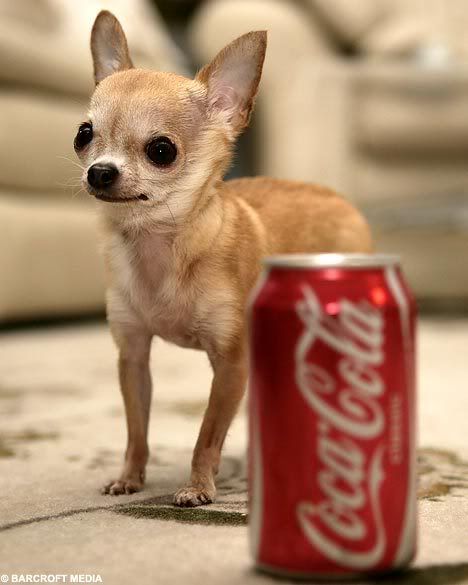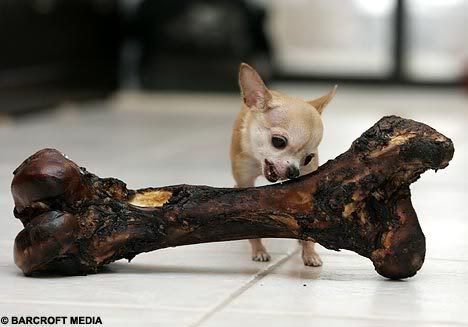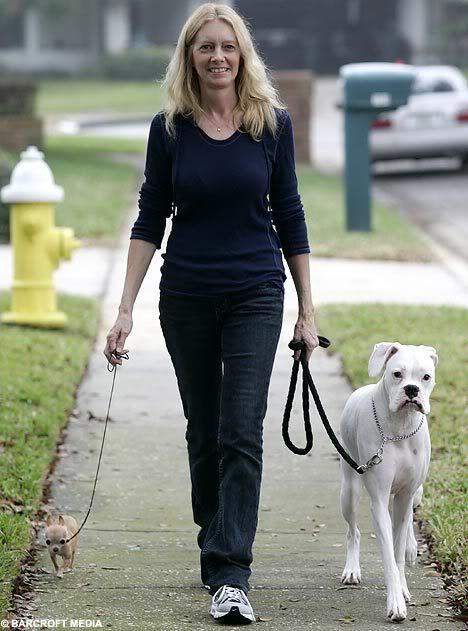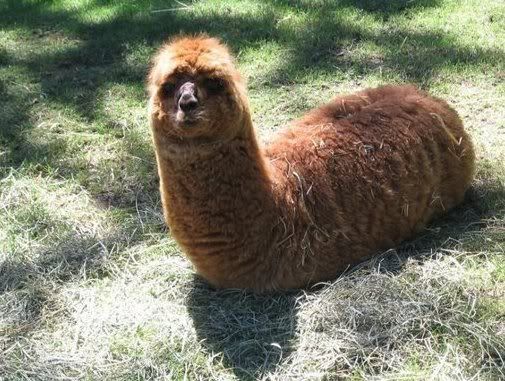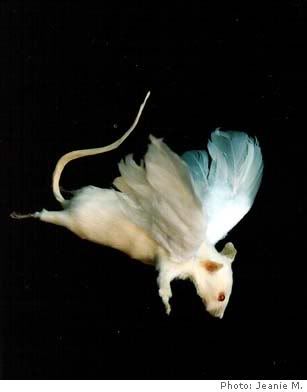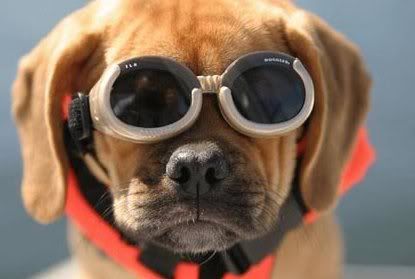 Ham, the first chimpanzee ever to ride into space is shown off by his animal trainer on January 31, 1961, at Cape Canaveral, Florida.
Ham was brought from the French Camaroons, West Africa, where he was born July 1957, to Holloman Air Force Base in New Mexico in 1959.
On January 31, 1961, Ham, whose name was an acronym for H olloman A ero M ed, became the first chimpanzee in space, aboard the Mercury Redstone rocket on a sub-orbital flight.
The spacecraft carrying Ham reached an altitude of 157 miles and a speed of 5857 mph. Ham performed well during his flight and splashed down in the Atlantic Ocean 60 miles from the recovery ship. He experienced a total of 6.6 minutes of weightlessness during a 16.5-minute flight.
Ham was placed on display at the Washington Zoo in 1963 where he lived alone until September 25, 1980. He then was moved to the North Carolina Zoological Park in Asheboro. Upon his death on January 17, 1983, Ham's body was preserved and loaned by the Smithsonian Institution to the International Space Hall of Fame in Alamogordo, New Mexico.
Source: NASA
Ham, the first chimpanzee ever to ride into space is shown off by his animal trainer on January 31, 1961, at Cape Canaveral, Florida.
Ham was brought from the French Camaroons, West Africa, where he was born July 1957, to Holloman Air Force Base in New Mexico in 1959.
On January 31, 1961, Ham, whose name was an acronym for H olloman A ero M ed, became the first chimpanzee in space, aboard the Mercury Redstone rocket on a sub-orbital flight.
The spacecraft carrying Ham reached an altitude of 157 miles and a speed of 5857 mph. Ham performed well during his flight and splashed down in the Atlantic Ocean 60 miles from the recovery ship. He experienced a total of 6.6 minutes of weightlessness during a 16.5-minute flight.
Ham was placed on display at the Washington Zoo in 1963 where he lived alone until September 25, 1980. He then was moved to the North Carolina Zoological Park in Asheboro. Upon his death on January 17, 1983, Ham's body was preserved and loaned by the Smithsonian Institution to the International Space Hall of Fame in Alamogordo, New Mexico.
Source: NASA
Thursday, January 31, 2008
Ham, the first chimpanzee astronaut
A Brief History of Animals in Space
Before humans actually went into space, one of the prevailing theories of the perils of space flight was that humans might not be able to survive long periods of weightlessness. American and Russian scientists utilized animals - mainly monkeys, chimps and dogs - in order to test each country's ability to launch a living organism into space and bring it back alive and unharmed. This article highlights of the history of animals involved in space flight, mostly monkeys, mice, and dogs. Also described are the early attempts with animals in sCreatepace flight, the first chimpanzee in space (Ham), the expansion of species in space (such as an Apollo flight that recorded spiders' attempts to spin webs in space), and other notable history. Source: NASA (via)
Wednesday, January 30, 2008
Update: "Bird Poop Video"
In a previous post, we linked to the "Bird Poops in Mouth Video" which has to be one of the most hilarious things around. Emil Steiner, at Off/Beat, now cautions that the video might be [oh horrors!] a hoax! Who cares. It's still funny. Right?
Have you had lunch yet?
 Witchetty grubs
Silkworm pupae
Scorpions
Stink bugs
Dragonflies
Mealworms
Grasshoppers
Tarantulas
Termites
Mopane caterpillars
Palm grubs
Crickets
Hungry? Bugs you can eat
(via)
Witchetty grubs
Silkworm pupae
Scorpions
Stink bugs
Dragonflies
Mealworms
Grasshoppers
Tarantulas
Termites
Mopane caterpillars
Palm grubs
Crickets
Hungry? Bugs you can eat
(via)
Holy cow! There's cows all over the place today
In Cincinnati, Ohio, searchers on the ground and in a sheriff's department helicopter Monday were looking for an Angus steer that postponed its date with a slaughterhouse by bolting out a gate that had been inadvertently left open. In Australia, police were forced to shoot a cow which was discovered toddling along a major motorway near the town of Nerang, 43 miles south of Brisbane, after it escaped from a nearby property. In Indonesia, a Boeing 737 was landing at Merauke airport in southwest Papua when it hit a calf which was running across the runway. The plane suffered damage to its left engine but no one was injured. The report did not say if the calf was killed. A Pennsylvania man has been sentenced to two years probation and 50 hours of community service for mailing a bloody cow's head to his wife's lover. In Quasqueton, Iowa, Keith Franck got an unexpected surprise when his cow gave birth to rare triplets. Triplets occur about once in 100,000 births among cows.
Thanks, I'll keep the job I have
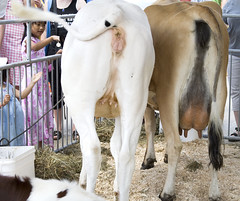 New Scientist magazine reports that working with manure can drastically reduce chances of developing lung cancer. Dairy farmers are five times less likely than the general populace to develop the disease.
The study found farmers typically breathed in dust that consisted largely of dried manure, and all the bacteria that grew in it.
New Scientist said adults who had a greater exposure to germs than usual might build up a better resistance to bugs, including cancer.
Source: Daily Telegraph
Photo: "Cow butt" uploaded by sarae
New Scientist magazine reports that working with manure can drastically reduce chances of developing lung cancer. Dairy farmers are five times less likely than the general populace to develop the disease.
The study found farmers typically breathed in dust that consisted largely of dried manure, and all the bacteria that grew in it.
New Scientist said adults who had a greater exposure to germs than usual might build up a better resistance to bugs, including cancer.
Source: Daily Telegraph
Photo: "Cow butt" uploaded by sarae
Moles are so cute!
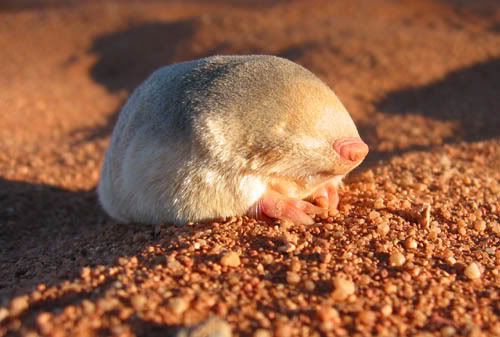 This is a Namib Desert Golden Mole, Eremitalpa granti namibensis.
There are more cute mole photos here.
Photo: G. Rathbun.
This is a Namib Desert Golden Mole, Eremitalpa granti namibensis.
There are more cute mole photos here.
Photo: G. Rathbun.
Flame Retardants Link to Tasmanian Devils Cancer
 A study conducted by the Australian government's National Measurement Institute took samples of fat from 16 living and dead Tasmanian devils, some of which suffered from the fatal devil facial-tumor disease (DFTD).
DFTD forms disfiguring tumors on the animals' faces and necks that cause them to die from starvation within about six months of showing symptoms.
The scientists found "high" levels of hexabromobiphenyl ether and "reasonably high" levels of decabromobiphenyl ether—chemicals used to treat electronics, textiles, and furniture.
The find triggered local media reports suggesting that the chemicals might be linked to the mysterious cancer that has been killing the rare marsupials for more than a decade.
Source: National Geographic
A study conducted by the Australian government's National Measurement Institute took samples of fat from 16 living and dead Tasmanian devils, some of which suffered from the fatal devil facial-tumor disease (DFTD).
DFTD forms disfiguring tumors on the animals' faces and necks that cause them to die from starvation within about six months of showing symptoms.
The scientists found "high" levels of hexabromobiphenyl ether and "reasonably high" levels of decabromobiphenyl ether—chemicals used to treat electronics, textiles, and furniture.
The find triggered local media reports suggesting that the chemicals might be linked to the mysterious cancer that has been killing the rare marsupials for more than a decade.
Source: National Geographic
Tuesday, January 29, 2008
Baby Panda in Vienna
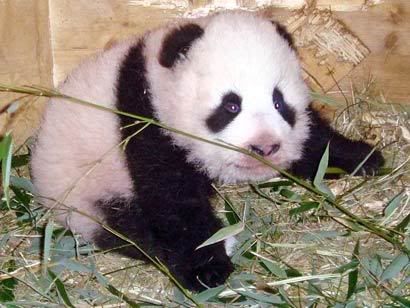 The first baby panda to be born in Europe in a quarter of a century has made his first public appearance.
Vienna Zoo's panda baby, Fu Long, has until now spent all his time with his over protective mother Yang Yang.
The zoo hopes that Fu Long will make more excursions into public view now he has taken the first step.
Source: Ananova
The first baby panda to be born in Europe in a quarter of a century has made his first public appearance.
Vienna Zoo's panda baby, Fu Long, has until now spent all his time with his over protective mother Yang Yang.
The zoo hopes that Fu Long will make more excursions into public view now he has taken the first step.
Source: Ananova
Albert the Bull
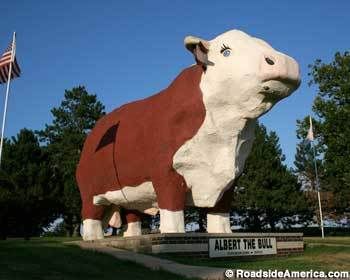 Albert, the World's Largest Bull, has been guarding the peaceful streets of Audubon since 1964. He is 30 feet tall and 33 feet long, and has a 15-foot span between horns. He also has baby blue eyes and giant concrete gonads.
He weighs 45 tons, and most of it is solid concrete. The steelwork that forms his mighty frame was salvaged from abandoned Iowa windmills.
Source: Roadside America
Albert, the World's Largest Bull, has been guarding the peaceful streets of Audubon since 1964. He is 30 feet tall and 33 feet long, and has a 15-foot span between horns. He also has baby blue eyes and giant concrete gonads.
He weighs 45 tons, and most of it is solid concrete. The steelwork that forms his mighty frame was salvaged from abandoned Iowa windmills.
Source: Roadside America
The Daily Mammal
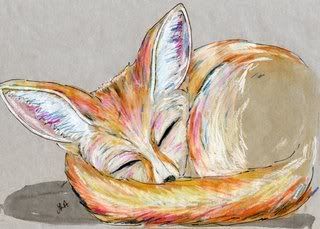 Jennifer Rae Atkins, in her blog, the Daily Mammal, is attempting to draw [close to] every mammal on earth. Therefore: a mammal a day. Since there are about 5,000 named mammal species, give or take, it should take her about 14 years to meet this goal. That's not so bad!
The Fennec Fox, at left, is one of my favorites.
Jennifer Rae Atkins, in her blog, the Daily Mammal, is attempting to draw [close to] every mammal on earth. Therefore: a mammal a day. Since there are about 5,000 named mammal species, give or take, it should take her about 14 years to meet this goal. That's not so bad!
The Fennec Fox, at left, is one of my favorites.
Cats in Space
Why is it that the first we hear of the cat is when it appears in Egypt around 2,000 B.C. as the living embodiment of the goddess Bast? The dog was domesticated...comfortably ensconced as man's adoring servant, catching frisbees and letting his tongue loll unattractively out of his mouth, long before the cat arrived on the scene. Why? Where was the cat? Why are there no images of cats in cave paintings? Why is the Bible silent on the subject? Keep reading - Nichole Hollander will answer all your question.
Monday, January 28, 2008
Art by Kent Rogowski - Bears
Kent Rogowki's Bears is a series of portraits of the most unusual sort: ordinary teddy bears that have been turned inside out and restuffed.
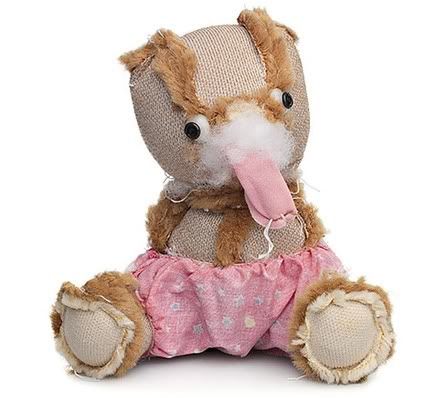 These bears, which have lived and loved and lost as much as their owners, have suffered and endured through it all. It is by virtue of revealing their inner core might we better understand our own.
(via)
These bears, which have lived and loved and lost as much as their owners, have suffered and endured through it all. It is by virtue of revealing their inner core might we better understand our own.
(via)
Sunday, January 27, 2008
When Pigs Fly
I didn't know that flying pigs were so frequently seen.
Paulus Tjiang Flying Pig
7" x 7" Pink glass complete with wings, bug eyes and kissy lips.
$275.00 at CBL Fine Art
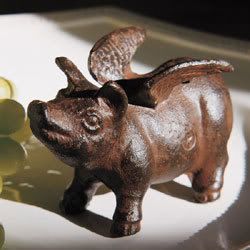 Iron Piggy Paper Weight
Combination paperweight and non-verbal response of "Yeah, right!"
$19.00 at Wisteria
Iron Piggy Paper Weight
Combination paperweight and non-verbal response of "Yeah, right!"
$19.00 at Wisteria
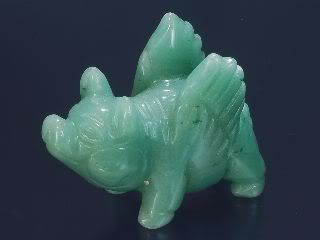 Gemstone Flying Pig
Carved in Aventurine stone
$15.00 at Exquisite Crystals
Gemstone Flying Pig
Carved in Aventurine stone
$15.00 at Exquisite Crystals
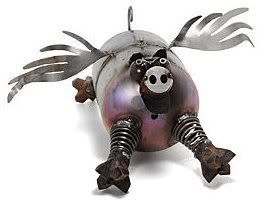 Flying Pig Lawn Ornament
Ready for either hanging or mounting on a stake,
$170.00 at Uncommon Goods
Flying Pig Lawn Ornament
Ready for either hanging or mounting on a stake,
$170.00 at Uncommon Goods
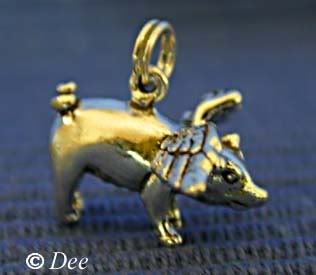 Flying Pig Jewelry
Earrings, Pendants, Charms, Pins
$26.00 and up at Dee Sharp Jewelry
Flying Pig Jewelry
Earrings, Pendants, Charms, Pins
$26.00 and up at Dee Sharp Jewelry
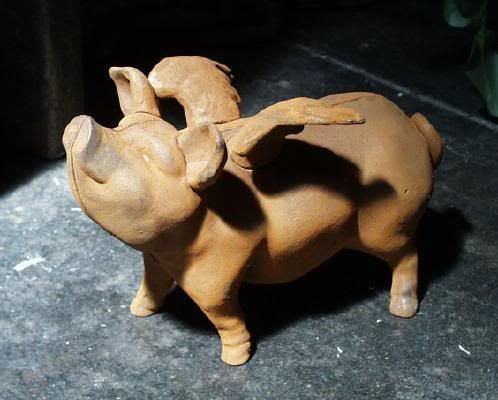 Flying Pig for home and garden
A rusty cast iron statue (and bank)
$29.00 at Stone Griffin
Flying Pig for home and garden
A rusty cast iron statue (and bank)
$29.00 at Stone Griffin
 Flying Pig Door Stop
Sturdy cast-iron design features a double-tiered base and a whimsical design.
$29.99 at GoCollect.com
Flying Pig Door Stop
Sturdy cast-iron design features a double-tiered base and a whimsical design.
$29.99 at GoCollect.com
 When Pigs Fly T-Shirt
In 2 colors and several sizes
Starting at $14.95 at GoWear
When Pigs Fly T-Shirt
In 2 colors and several sizes
Starting at $14.95 at GoWear
 Pig Flying Hat
Pull the chin string to flap the wings. Size fits most adults. Approximately 15"L.
$4.95 at US Toy Company
Pig Flying Hat
Pull the chin string to flap the wings. Size fits most adults. Approximately 15"L.
$4.95 at US Toy Company
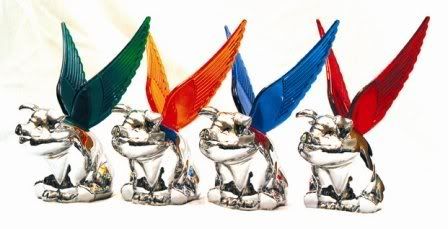 Flying Pig Hood Ornament
Customize your vehicle, or try these hood ornaments on boats, golf carts, plaques, trophies or promotional items.
$46.72 and up at Truck Customizers
Flying Pig Hood Ornament
Customize your vehicle, or try these hood ornaments on boats, golf carts, plaques, trophies or promotional items.
$46.72 and up at Truck Customizers
Saturday, January 26, 2008
You can help Georgia dogs
Saving Georgia Dogs, Inc. is participating in a challenge being offered Six Degrees, partnered with the Case Foundation and Parade for America's Giving Challenge. The four charity badges that have the most unique donors will receive $50,000 for their cause. This could mean hundreds more lives saved in Georgia's kill shelters. They need your help!! The Challenge ends on January 31, 2008 at 3:00 pm eastern. SGD is a non profit 501(c)3 animal welfare organization and licensed rescue. All donations are tax deductible. The winners are determined by the number of donations, not the amount of money donated. They just need $10 donations to help them win! Please donate by clicking the orange donate button HERE. Georgia euthanizes 90,000 adoptable dogs each year, more than New York, New Jersey and Oregon combined. Another horrible fact is that some shelters in Georgia still use the gas chamber as a means of euthanizing these animals; it’s a cruel and inhumane death. The goal of SGD to stop this practice and to implement plans that not only rescues many more animals from shelters, but to help prevent animals from ending up in these shelters in the first place. Their goal is to implement programs for spay/neuter clinics and to lobby for mandatory spay/neuter requirements in local counties, to start a heart worm prevention/treatment fund to help low income families keep their pets healthy, humane education programs for local schools and a program to help victims of domestic violence who are staying in abusive situations because they don’t want to surrender their pets.
Friday, January 25, 2008
Police Puppy Training Diary
 Police in Scotland have set up a Web site to allow the public to meet their newest, and cutest, recruit as he learns how to sniff out criminals.
He's a six-week-old German Shepherd puppy and he is so new to the Force he doesn't even have a name yet!
One of a litter of seven pups bred especially for police work by Lothian and Borders Police, you can follow our new recruit's progress over the coming months on this special diary page.
Source: Yahoo News
Police in Scotland have set up a Web site to allow the public to meet their newest, and cutest, recruit as he learns how to sniff out criminals.
He's a six-week-old German Shepherd puppy and he is so new to the Force he doesn't even have a name yet!
One of a litter of seven pups bred especially for police work by Lothian and Borders Police, you can follow our new recruit's progress over the coming months on this special diary page.
Source: Yahoo News
It's a boy!
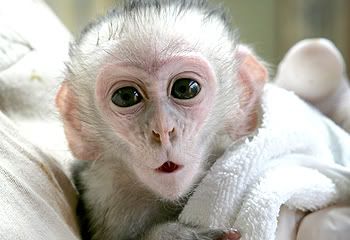 Three-week-old Jed was examined for the first time since he was born and staff at the Werribee Open Range Zoo were pleased to discover he is a boy. Jed is a vervet monkey.
Source: Herald Sun
(via)
Three-week-old Jed was examined for the first time since he was born and staff at the Werribee Open Range Zoo were pleased to discover he is a boy. Jed is a vervet monkey.
Source: Herald Sun
(via)
Photography by Anna Kuperberg
Anna Kuperberg photographs dogs. She made this blog, SlobberSpace, to entertain you and to help you procrastinate your boring office work. There is no useful information on this blog, no training advice, and no breed analysis. Just happy, goofy dogs.

Thursday, January 24, 2008
Pet Turtles Linked to Rise in Salmonella Infections
The sale of small turtles has been banned in the United States since 1975, but the number of these reptiles being purchased for children has been increasing, according to the U.S. Centers for Disease Control and Prevention. Small pet turtles were to blame for 103 cases of Salmonella infection in the second half of last year, mostly in young children, but the true number of infections with the potentially fatal bacteria is undoubtedly much higher. Many people aren't aware of the risk of Salmonella infections from pet turtles. Only 20 percent of these cases said they were aware there was a connection between Salmonella infection and reptile exposure. Source: U.S. News
You think your favorite restaurant is too far to drive?
 A leatherback sea turtle recently completed the longest recorded migration of any sea vertebrate: 12,774 miles across the Pacific Ocean.
The giant reptile began the trek in Indonesia's warm tropical waters in the summer of 2003 and traveled 647 days just to eat jellyfish off Oregon, in the cool waters of the Pacific Northwest.
Source: National Geographic
A leatherback sea turtle recently completed the longest recorded migration of any sea vertebrate: 12,774 miles across the Pacific Ocean.
The giant reptile began the trek in Indonesia's warm tropical waters in the summer of 2003 and traveled 647 days just to eat jellyfish off Oregon, in the cool waters of the Pacific Northwest.
Source: National Geographic
The 5 Most Horrifying Bugs in the World
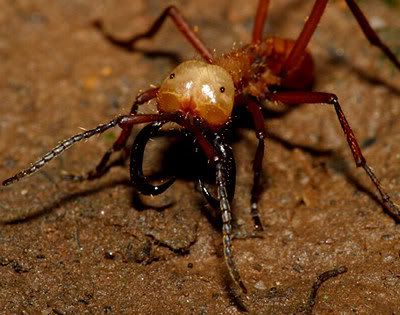 There are about 10,000,000,000,000,000,000 insects on earth at any given moment. Seriously, that's a real number. For every one of us, there are 1.5 billion bugs.
But some of them are so horrifying, just one is too many. Cracked showcases five insects you want to avoid at all costs.
These are really creepy!
There are about 10,000,000,000,000,000,000 insects on earth at any given moment. Seriously, that's a real number. For every one of us, there are 1.5 billion bugs.
But some of them are so horrifying, just one is too many. Cracked showcases five insects you want to avoid at all costs.
These are really creepy!
Wednesday, January 23, 2008
Teach your kids
A good lesson for those of us trying to teach our children and grandchildren not to be afraid of dogs and to treat animals with respect, Terrierman points out that it is NOT always OK to pet a strange dog, or to leave small helpless children alone with dogs. "A dog that bites does not violate any laws of nature. And, as uncomfortable as it may make some breed defenders, biting is very much in the nature of all dogs, and some breeds in particular. A Jack Russell is one of them. "
I think I'll stick to Godiva, thank you
 Pink Tentacle has discovered a unique chocolate made to look like a beetle larva. They say this confection has captured the fancy of candy aficionados in Japan. Produced by the Komatsuya confectionery and bakery based in Akita prefecture, the bite-sized Larva Chocolates (Youchu Choco) have a grub-shaped body made from milk chocolate and corn flakes, a layer of skin made from white chocolate, legs made from tiny strips of dried squid, and a dainty mouth made from orange peel.
Pink Tentacle has discovered a unique chocolate made to look like a beetle larva. They say this confection has captured the fancy of candy aficionados in Japan. Produced by the Komatsuya confectionery and bakery based in Akita prefecture, the bite-sized Larva Chocolates (Youchu Choco) have a grub-shaped body made from milk chocolate and corn flakes, a layer of skin made from white chocolate, legs made from tiny strips of dried squid, and a dainty mouth made from orange peel.
Elephants are evolving smaller tusks
 The average tusk size of African elephants has halved since the mid-19th century. A similar effect has been spotted in the Asian elephant population in India.
Researchers say it is an example of Darwinism in action, caused by the mass slaughter of dominant male elephants - but whereas evolution normally takes place over thousands of years, these changes have occurred within 150 years.
Zoologists at Oxford University fear that poaching and hunting of the largest male elephants, which also have the largest tusks, has changed the natural breeding behaviour of these animals. Their research has shown that the hunting of these large males for their ivory allows smaller males with shorter tusks to produce more calves. Over time the average tusk size decrease
Source: Telegraph
The average tusk size of African elephants has halved since the mid-19th century. A similar effect has been spotted in the Asian elephant population in India.
Researchers say it is an example of Darwinism in action, caused by the mass slaughter of dominant male elephants - but whereas evolution normally takes place over thousands of years, these changes have occurred within 150 years.
Zoologists at Oxford University fear that poaching and hunting of the largest male elephants, which also have the largest tusks, has changed the natural breeding behaviour of these animals. Their research has shown that the hunting of these large males for their ivory allows smaller males with shorter tusks to produce more calves. Over time the average tusk size decrease
Source: Telegraph
Oregon Rancher Crosses US on Horseback
 An Oregon rancher who set off on a cross-country horseback ride seven months ago in search of what's good in America finished his trip feeling encouraged by the spirit and stories of the people he met.
Bill Inman began his journey June 2 because he felt distress over how the country was being portrayed in news coverage and on TV shows. He rode his 16-year-old thoroughbred-quarter horse Blackie.
Inman finished his trip riding into the southwestern North Carolina town under overcast skies. A crowd of more than 100 people greeted Inman at a motorcycle dealership as he ended the journey.
Source: Washington Post
(via)
An Oregon rancher who set off on a cross-country horseback ride seven months ago in search of what's good in America finished his trip feeling encouraged by the spirit and stories of the people he met.
Bill Inman began his journey June 2 because he felt distress over how the country was being portrayed in news coverage and on TV shows. He rode his 16-year-old thoroughbred-quarter horse Blackie.
Inman finished his trip riding into the southwestern North Carolina town under overcast skies. A crowd of more than 100 people greeted Inman at a motorcycle dealership as he ended the journey.
Source: Washington Post
(via)
Tuesday, January 22, 2008
Recent Doggie News
 * Since 2001, Southwest Florida International has used a 9-year-old border collie named Radar to patrol the runways and chase away birds. Birds being sucked into aircraft engines is one of the most persistent safety problems at airports. Border collies scare the birds but don't harm them.
* Grace Saenz-Lopez, the mayor of Alice, Texas, has been indicted after neighbors accused her of taking their dog, a 5-pound Shih Tzu, while she cared for it during their vacation.
The day after her neighbors left with their kids for vacation, Saenz-Lopez called to tell them that their dog Puddles had died. But three months later, the same dog, now renamed Panchito, was spotted at a local dog groomer. When Saenz-Lopez refused to return the dog, the family filed a criminal complaint and a civil lawsuit against her.
* Derick Phanord who killed his dog, Maximus, by pouring gasoline on the pit bull and setting it on fire, was sentenced Tuesday to 2 years in prison for animal cruelty.
"I am not a monster. I am a good guy," a weeping Phanord, 22, said before his sentencing. "I am an animal lover," he said.
* The Fort Worth City Council approved an ordinance Tuesday banning dog tethering. The new ordinance, which becomes effective this week, makes it illegal to use a chain, rope, tether, leash, cable or other device to attach an unattended dog to a stationary object or trolley system. A dog still must be confined within a secure enclosure at all times.
* Since 2001, Southwest Florida International has used a 9-year-old border collie named Radar to patrol the runways and chase away birds. Birds being sucked into aircraft engines is one of the most persistent safety problems at airports. Border collies scare the birds but don't harm them.
* Grace Saenz-Lopez, the mayor of Alice, Texas, has been indicted after neighbors accused her of taking their dog, a 5-pound Shih Tzu, while she cared for it during their vacation.
The day after her neighbors left with their kids for vacation, Saenz-Lopez called to tell them that their dog Puddles had died. But three months later, the same dog, now renamed Panchito, was spotted at a local dog groomer. When Saenz-Lopez refused to return the dog, the family filed a criminal complaint and a civil lawsuit against her.
* Derick Phanord who killed his dog, Maximus, by pouring gasoline on the pit bull and setting it on fire, was sentenced Tuesday to 2 years in prison for animal cruelty.
"I am not a monster. I am a good guy," a weeping Phanord, 22, said before his sentencing. "I am an animal lover," he said.
* The Fort Worth City Council approved an ordinance Tuesday banning dog tethering. The new ordinance, which becomes effective this week, makes it illegal to use a chain, rope, tether, leash, cable or other device to attach an unattended dog to a stationary object or trolley system. A dog still must be confined within a secure enclosure at all times.
Deaths of Rare Crocodile in India Stir Alarm
 Three decades after it was brought back from the brink of extinction, the rare Indian crocodile known as the gharial is turning up dead by the dozens on the banks of a river called the Chambal. Forest officials are at a loss to explain why.
Since mid-December, the National Chambal Wildlife Sanctuary has confirmed 76 deaths along the river, which begins in the central Indian state of Madhya Pradesh and runs through Rajasthan and Uttar Pradesh.
Other species that inhabit the Chambal River ecosystem, including dozens of fish species on which the gharials feed, appear to be healthy.
Sourge: NY Times
Photo: Tim Dwight(Wildldife Web)
Three decades after it was brought back from the brink of extinction, the rare Indian crocodile known as the gharial is turning up dead by the dozens on the banks of a river called the Chambal. Forest officials are at a loss to explain why.
Since mid-December, the National Chambal Wildlife Sanctuary has confirmed 76 deaths along the river, which begins in the central Indian state of Madhya Pradesh and runs through Rajasthan and Uttar Pradesh.
Other species that inhabit the Chambal River ecosystem, including dozens of fish species on which the gharials feed, appear to be healthy.
Sourge: NY Times
Photo: Tim Dwight(Wildldife Web)
The Art of Dead Mice
Carnivores released into wild 'fail and die'
 Most carnivores bred in captivity and released back into the wild fail to cope and die, according to a study published online in the journal Biological Conservation.
Researchers are calling for a complete rethink of such reintroductions before others are carried out, including the suggested release of animals such as the lynx, wildcat and wolf into Scotland.
The scientists from Exeter University looked at 45 reintroductions, involving 17 carnivore species. It found that over half the animals were killed by humans, generally in shootings and car accidents.
For example, of 46 captive-bred lynx released into Switzerland, only 15 survived.
Five wolves released into Yellowstone national park in the United States were shot by ranchers bordering the park.
The study also found captive animals were more susceptible to starvation and disease than their wild counterparts and less able to form successful social groups.
Source: Telegraph
Most carnivores bred in captivity and released back into the wild fail to cope and die, according to a study published online in the journal Biological Conservation.
Researchers are calling for a complete rethink of such reintroductions before others are carried out, including the suggested release of animals such as the lynx, wildcat and wolf into Scotland.
The scientists from Exeter University looked at 45 reintroductions, involving 17 carnivore species. It found that over half the animals were killed by humans, generally in shootings and car accidents.
For example, of 46 captive-bred lynx released into Switzerland, only 15 survived.
Five wolves released into Yellowstone national park in the United States were shot by ranchers bordering the park.
The study also found captive animals were more susceptible to starvation and disease than their wild counterparts and less able to form successful social groups.
Source: Telegraph
Big Horses
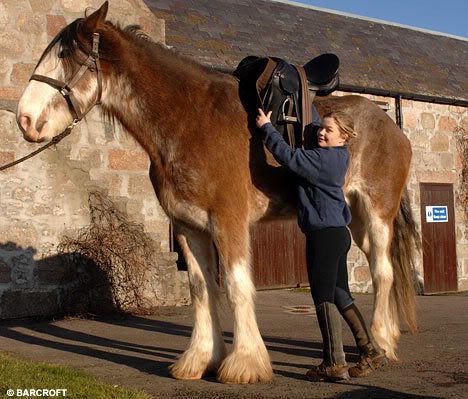 At 6ft 6ins and still growing, Digger the Clydesdale has become Britain's biggest horse, according to the Daily Mail.
Best estimates put the strapping Clydesdale at 19 hands and two inches (6ft 6in) - on a par with Britain's biggest living horse.
And at just four years old, Digger is the equivalent in equine terms to a teenager so there is still time for him to grow.
At 6ft 6ins and still growing, Digger the Clydesdale has become Britain's biggest horse, according to the Daily Mail.
Best estimates put the strapping Clydesdale at 19 hands and two inches (6ft 6in) - on a par with Britain's biggest living horse.
And at just four years old, Digger is the equivalent in equine terms to a teenager so there is still time for him to grow.
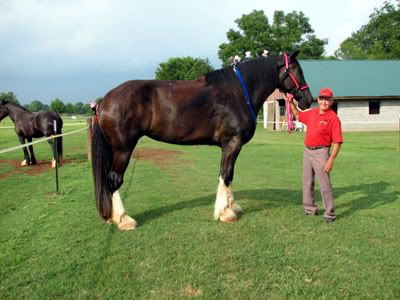 Tina, from Niota, Tennessee is now in the Guinness Book of World Records for 2008 as the Tallest Horse in the World.
At 20 hands tall, Tina is nearly seven feet tall. She has taken the top spot from former record holder Radar who is a little more than 19 hands tall.
Tina should have no problem holding on to her new title. Her owners expect her to continuing growing, topping out around 23 hands.
Tina, from Niota, Tennessee is now in the Guinness Book of World Records for 2008 as the Tallest Horse in the World.
At 20 hands tall, Tina is nearly seven feet tall. She has taken the top spot from former record holder Radar who is a little more than 19 hands tall.
Tina should have no problem holding on to her new title. Her owners expect her to continuing growing, topping out around 23 hands.
Monday, January 21, 2008
Skimming the news
* A Montana man says he was lucky to find a mechanic without a snake phobia when his pet Burmese python hid under the dashboard of his car. * In Britain, six abandoned kittens have found an unexpected new mother figure - a pet rabbit.
Too important not to mention
This is NOT a pet or animal related post, but it's about a subject that is increasingly scaring and frustrating to me ...
Autism - it's the fastest-growing developmental disability, with 1 in 150 births, now affecting 1 to 1.5 million Americans, and with a 10 - 17 % annual growth.
Would you like to help in a VERY EASY way?
The band, Five for Fighting, is generously donating $0.49 to Autism Speaks for each time this video is viewed. The funding goes toward research studies to help find a cure.
When you have a moment, please visit the link to watch the video and pass it along to friends and family. They are aiming for 10,000 hits, but hopefully we can help to exceed that goal.
Italian mozzarella is threatened
 The production of one of Italy's best known exports, mozzarella, is under threat from an infection spreading through herds of water buffalo.
Mozzarella di bufala is not only an essential part of the Italian diet, but one of Italy's most important exports.
The Italian government has set up an emergency commission to try and stop the spread of the disease, which affects milk production.
In the next two months, the Italian government will start the slaughter of 32,000 buffalo, infected with Brucellosis - a contagious bacterial disease that in livestock leads to abortion, infertility and reduced milk production.
It can be transmitted through food to humans, causing severe intermittent fever - though the milk which produces the cheese is perfectly safe when it is pasteurised.
Source: BBC
(via)
The production of one of Italy's best known exports, mozzarella, is under threat from an infection spreading through herds of water buffalo.
Mozzarella di bufala is not only an essential part of the Italian diet, but one of Italy's most important exports.
The Italian government has set up an emergency commission to try and stop the spread of the disease, which affects milk production.
In the next two months, the Italian government will start the slaughter of 32,000 buffalo, infected with Brucellosis - a contagious bacterial disease that in livestock leads to abortion, infertility and reduced milk production.
It can be transmitted through food to humans, causing severe intermittent fever - though the milk which produces the cheese is perfectly safe when it is pasteurised.
Source: BBC
(via)
Cat Tattoo
Why would someone do this? I can't figure it out. Is this an extreme cat lover? Or just an extremely offensive person? Photo found at Sling's Domain.
Play a game - feed rescued pets
Provide food to abandoned (and often abused) dogs and cats just by playing the trivia game here. For every question you answer correctly, Experience Project donates the equivalent of 1 kibble of food to Rocket Dog Rescue & the Urban Cat Project, helping save pet's lives. The more you play, the more shelter pets they can feed! Spread the word and make a huge difference! (via)
Weirdest and most endangered creatures
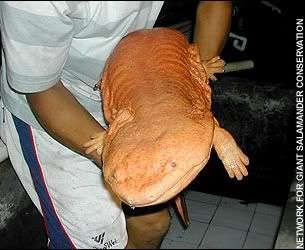 Amphibians as a rule are not cute and cuddly which puts them way down the pecking order of species that need to be saved.
But they are a key indicator species and if they start to decline it is a clear warning that the environment is in trouble.
The Zoological Society of London (ZSL) has drawn up a list of some of the world's most extraordinary creatures threatened with extinction.
They found 85 per cent of the top 100 of the 'world's weirdest and most endangered creatures' are receiving little conservation attention and will disappear if no action is taken.
ZSL has identified and is starting work to protect 10 of the most unusual and threatened EDGE amphibian species this year. They include:
*Chinese giant salamander (salamander that can grow up to 1.8m in length and evolved independently from all other amphibians over 100m years before Tyrannosaurus rex)
*Sagalla caecilian (limbless amphibian with sensory tentacles on the sides of its head)
*Purple frog (purple-pigmented frog that was only discovered in 2003 because it spends most of the year buried up to 4m underground)
*Ghost frogs of South Africa (one species is found only in the traditional human burial grounds of Skeleton Gorge in Table Mountain, South Africa)
*Olm (blind salamander with transparent skin that lives underground, hunts for its prey by smell and electrosensitivity and can survive without food for 10 years)
*Lungless salamanders of Mexico (highly endangered salamanders that do not have lungs but instead breathe through their skin and mouth lining)
*Malagasy rainbow frog (highly-decorated frog that inflates itself when under threat and can climb vertical rock surfaces)
*Chile Darwin's frog (a frog where fathers protect the young in their mouths, this species has not been officially seen since around 1980 and may now be extinct)
*Betic midwife toad (toads that evolved from all others over 150m years ago - the males carry the fertilised eggs wrapped around their hind legs)
*Gardiner's Seychelles frog (perhaps the world's smallest frog, with adults growing up to just 11mm in length - the size of a drawing pin)
Source: Telegraph
Amphibians as a rule are not cute and cuddly which puts them way down the pecking order of species that need to be saved.
But they are a key indicator species and if they start to decline it is a clear warning that the environment is in trouble.
The Zoological Society of London (ZSL) has drawn up a list of some of the world's most extraordinary creatures threatened with extinction.
They found 85 per cent of the top 100 of the 'world's weirdest and most endangered creatures' are receiving little conservation attention and will disappear if no action is taken.
ZSL has identified and is starting work to protect 10 of the most unusual and threatened EDGE amphibian species this year. They include:
*Chinese giant salamander (salamander that can grow up to 1.8m in length and evolved independently from all other amphibians over 100m years before Tyrannosaurus rex)
*Sagalla caecilian (limbless amphibian with sensory tentacles on the sides of its head)
*Purple frog (purple-pigmented frog that was only discovered in 2003 because it spends most of the year buried up to 4m underground)
*Ghost frogs of South Africa (one species is found only in the traditional human burial grounds of Skeleton Gorge in Table Mountain, South Africa)
*Olm (blind salamander with transparent skin that lives underground, hunts for its prey by smell and electrosensitivity and can survive without food for 10 years)
*Lungless salamanders of Mexico (highly endangered salamanders that do not have lungs but instead breathe through their skin and mouth lining)
*Malagasy rainbow frog (highly-decorated frog that inflates itself when under threat and can climb vertical rock surfaces)
*Chile Darwin's frog (a frog where fathers protect the young in their mouths, this species has not been officially seen since around 1980 and may now be extinct)
*Betic midwife toad (toads that evolved from all others over 150m years ago - the males carry the fertilised eggs wrapped around their hind legs)
*Gardiner's Seychelles frog (perhaps the world's smallest frog, with adults growing up to just 11mm in length - the size of a drawing pin)
Source: Telegraph
The Whale Hunt - A Story in 3214 Photos
From May 1 to May 7, Jonathan Harris took a photo every 5 minutes of an Inupiat Whale Hunt near Barrow Alaska. (via)
Is your dog a little stinker?
 Veterinarian formulated and recommended dietary supplement helps balance your pet's digestive system to reduce excessive gas. And, the great flavor means your dog will eat Doggie-Bites like a treat.
$6.50 at Healthy Pet Company
(via)
Veterinarian formulated and recommended dietary supplement helps balance your pet's digestive system to reduce excessive gas. And, the great flavor means your dog will eat Doggie-Bites like a treat.
$6.50 at Healthy Pet Company
(via)
Beef for Dinner, Bones for Surgery
 Prather Ranch's dry-aged, organic New York steaks will set you back $20 per pound at its upscale stall in San Francisco's Ferry Building farmers market. But even at that price, foodies aren't the company's best market.
The most valuable parts of its cows are the inedible parts: pituitary glands, bones, heart muscles and hides. Medical companies covet them for making surgical glue, bone screws, collagen and artificial skin.
"In most years, these things are more valuable than the meat," said Jim Rickert, a fifth-generation farmer. "We also think out of an ethical-moral thing. The animal deserves us using it completely."
Photo: Foot bones from Prather Ranch cows are cleaned, then turned into a variety of implants for humans, including these screws for knee surgeries.
Image: Regeneration Technologies
(via)
Prather Ranch's dry-aged, organic New York steaks will set you back $20 per pound at its upscale stall in San Francisco's Ferry Building farmers market. But even at that price, foodies aren't the company's best market.
The most valuable parts of its cows are the inedible parts: pituitary glands, bones, heart muscles and hides. Medical companies covet them for making surgical glue, bone screws, collagen and artificial skin.
"In most years, these things are more valuable than the meat," said Jim Rickert, a fifth-generation farmer. "We also think out of an ethical-moral thing. The animal deserves us using it completely."
Photo: Foot bones from Prather Ranch cows are cleaned, then turned into a variety of implants for humans, including these screws for knee surgeries.
Image: Regeneration Technologies
(via)
Sunday, January 20, 2008
Cat wine decanter
 Sitting Cat wine caddy.
Also available: dog, pig, reindeer and moose.
$69.95 at Colorado Wine
(via)
Sitting Cat wine caddy.
Also available: dog, pig, reindeer and moose.
$69.95 at Colorado Wine
(via)
Dallas to Dallas Ride for Wet Noses
 Inspired by Randy Boudouris's ride to benefit Cystic Fibrosis, Bill Craig will set off in April of 2008 to bike from Dallas, Texas to Dallas, Georgia to raise awareness for the need to Spay, Neuter, and Adopt. This ride will also raise funds for various shelters & humane societies along his route.
Craig is riding in support of the Spay, Neuter and Adopt message, and he will be stopping at many different animal shelters along his route to talk to people about the importance of spaying, neutering and adopting pets.
Visit his website http://www.d2d4wetnoses.com/ where he has a lot more information about his trek.
Inspired by Randy Boudouris's ride to benefit Cystic Fibrosis, Bill Craig will set off in April of 2008 to bike from Dallas, Texas to Dallas, Georgia to raise awareness for the need to Spay, Neuter, and Adopt. This ride will also raise funds for various shelters & humane societies along his route.
Craig is riding in support of the Spay, Neuter and Adopt message, and he will be stopping at many different animal shelters along his route to talk to people about the importance of spaying, neutering and adopting pets.
Visit his website http://www.d2d4wetnoses.com/ where he has a lot more information about his trek.
Robo-pet pins
 The industrial quality of this canine only adds to its charm. And haven't you always wanted a cat that doesn't shed?
Slightly robotic and mechanical, but completely alluring, artist Thomas Mann has created atypical accessories that allow dog and cat lovers to show their pet pride without being overly cutesy.
A combination of sterling silver and brass accents, these pins combine sturdy craftsmanship, playful imagination and a true appreciation for our four-legged friends. Handmade in New Orleans.
$136.00 at Uncommon Goods
The industrial quality of this canine only adds to its charm. And haven't you always wanted a cat that doesn't shed?
Slightly robotic and mechanical, but completely alluring, artist Thomas Mann has created atypical accessories that allow dog and cat lovers to show their pet pride without being overly cutesy.
A combination of sterling silver and brass accents, these pins combine sturdy craftsmanship, playful imagination and a true appreciation for our four-legged friends. Handmade in New Orleans.
$136.00 at Uncommon Goods
Robots by Ann Smith
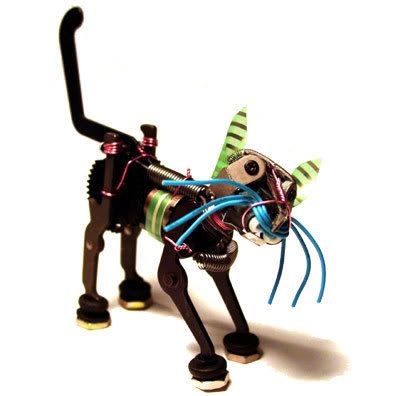 Ann Smith is a graduate of the Rhode Island School of Design in Illustration. She creates robot-like animal sculptures out of broken electronics and machines which are sold in stores and galleries throughout the United States.
Ann Smith is a graduate of the Rhode Island School of Design in Illustration. She creates robot-like animal sculptures out of broken electronics and machines which are sold in stores and galleries throughout the United States.
The art of war
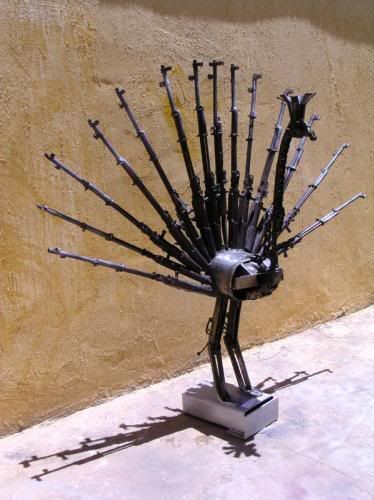 In 1998, the Cambodian government destroyed 125,000 weapons across the country.
The Peace Art Project Cambodia (PAPC) was created in November 2003 to get rid of the weapons in an artistic way.
See pictures of weapons sculpture and furniture at funnytogo.com.
(via)
In 1998, the Cambodian government destroyed 125,000 weapons across the country.
The Peace Art Project Cambodia (PAPC) was created in November 2003 to get rid of the weapons in an artistic way.
See pictures of weapons sculpture and furniture at funnytogo.com.
(via)
Saturday, January 19, 2008
How Baboons Think
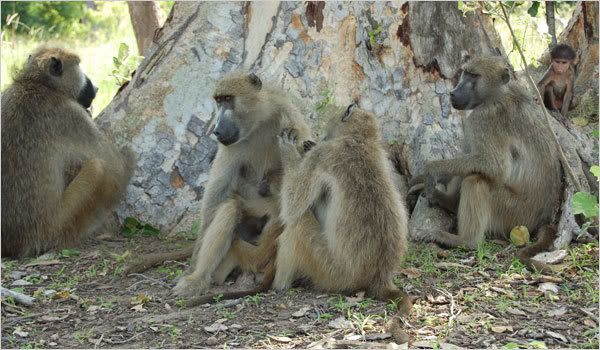 Dorothy Cheney and Robert Seyfarth, a husband-and-wife team of biologists at the University of Pennsylvania, have spent 14 years observing the Moremi baboons. Through ingenious playback experiments performed by themselves and colleagues, the researchers say they have worked out many aspects of what baboons use their minds for, along with their limitations.
Reading a baboon’s mind affords an excellent grasp of the dynamics of baboon society. But more than that, it bears on the evolution of the human mind and the nature of human existence.
Dr. Cheney and Dr. Seyfarth have summed up their new cycle of research in a book titled “Baboon Metaphysics
Dorothy Cheney and Robert Seyfarth, a husband-and-wife team of biologists at the University of Pennsylvania, have spent 14 years observing the Moremi baboons. Through ingenious playback experiments performed by themselves and colleagues, the researchers say they have worked out many aspects of what baboons use their minds for, along with their limitations.
Reading a baboon’s mind affords an excellent grasp of the dynamics of baboon society. But more than that, it bears on the evolution of the human mind and the nature of human existence.
Dr. Cheney and Dr. Seyfarth have summed up their new cycle of research in a book titled “Baboon Metaphysics.” Their conclusion, based on many painstaking experiments, is that baboons’ minds are specialized for social interaction, for understanding the structure of their complex society and for navigating their way within it.
“Monkey society is governed by the same two general rules that governed the behavior of women in so many 19th-century novels,” Dr. Cheney and Dr. Seyfarth write. “Stay loyal to your relatives (though perhaps at a distance, if they are an impediment), but also try to ingratiate yourself with the members of high-ranking families.”
NY Times

